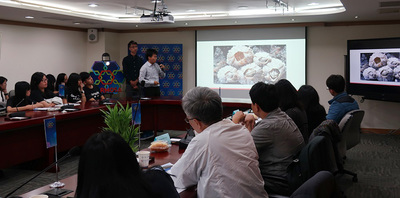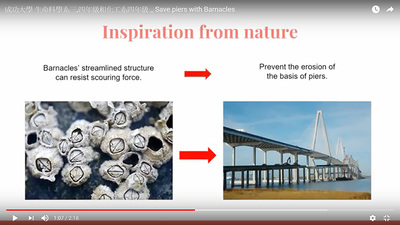NCKU Awarded First Prize in Open Audition 2018 Biomimicry Global Design Challenge Taiwan Competition


The Fermanian Business & Economic Institute (FBEI) has predicted that by 2030 biomimicry industries across the globe will be worth 1.6 trillion US dollars. This indicates the scale of the momentum of biomimicry and bionic technology. In keeping with this trend, NCKU has made considerable achievements in biomimicry. One such success was the project Save Piers with Barnacles, which was the result of teamwork by Zhi-Hao Shi, Li-Chin Wang, Chung-Yu Chen, Chih-Chieh Chan and Hui-Yun Sun from the Department of Life Sciences, and Hsueh-Wen Lai, from the Department of Biotechnology and Biochemical Engineering. Under the guidance of Song-Bin Chang, associate professor of the Department of Life Sciences, these students were inspired by the behavior of barnacles to strengthen bridge piers. This strengthening serves to reduce the devastating effects of flooding and extreme rainfall. This project won first prize in the open audition of the 2018 Biomimicry Global Design Challenge Taiwan Competition. It was consequently entered in the Biomimicry Global Design Challenge held in the US.
The term ‘biomimicry’ was coined by biologist Janine Benyus, and has been defined as a cross-disciplinary science. An iconic example of biomimicry is that of Velcro. Its inventor George de Mestral invented Velcro in 1948 after seeing his dog covered with burrs. Another example is the waterproof fabric inspired by the self-cleaning hydrophobic properties of the lotus leaf (aka “the lotus effect”).
According to one of the team members, Chung-Yu Chen, the student-winners of NCKU originally focused on drosera and fireflies as their inspiration. But when Chih-Chieh Chan, who is enthusiastic about arthropods, suggested exploring the behavior of barnacles, the team realized they had hit upon a winning idea. Barnacles permanently adhere themselves to hard surfaces such as the bottom of ships. They have developed amazing survival strategies to counter vortexes and alluvion. Hence, the team decided to apply lessons learned from the humble barnacle in the design of refuges and shelters for areas frequented by tsunamis.
Advisor Song-Bin Chang suggested focusing on climate change. As natural disasters like storms or deluges have aggravated in scale and frequency due to global warming, they have led to serious damage to bridge piers. To resolve this problem, the team started to think of solutions to help strengthen pier foundations. Zhi-Hao Shi explained that they decided to focus on the reconstruction of neglected piers in remote areas. Competition adjudicators expressed their approval of using the structure of bridges to divert waters, which they believed to be an innovative engineering application. Bridge infrastructure is an ongoing concern of many governments; hence, this ingenious invention fulfills humanitarian and practical purposes simultaneously.
“When we arrived at the competition venue, we looked around and suddenly felt that our video and PowerPoint presentation were not eye-catching enough. Our confidence dipped, and we returned to Tainan in low spirits. It was such a delightful surprise therefore to learn that we were the winner of this contest. We were so glad!” Hui-Yun Sun recalled that that day she felt she was riding a roller coaster when she learned this good news: “I was rather drowsy in the wee hours of April 25th, but I was instantly energized when I heard that we won first prize!”
From the inception to completion, there were only two months to prepare this project. The success of this team is attributable to the genuine interest of the students in bioscience and the fast-growing sector of biomimicry. They intend to explore biomimicry through a host of real-world problems. Zhi-Hao Shi,Chung-Yu Chen, and Chih-Chieh Chan enjoy observing flora and fauna life. They have pored over books and magazines, and watched TV programs about animal life since childhood. Hui-Yun Sun chose aquatic ferns as a theme for a scientific exhibition when she was in senior high school. She was so fascinated by the mystery of biological growth that she decided to major in life sciences. Li-Chin Wang is interested in genetics and biomolecules.
Hsueh-Wen Lai played a pivotal role in the team. She functioned as the expert on fluid mechanics and proffered practical suggestions in the formulation and assessment of repair and strengthening of bridge piers, and collected a wealth of data to support their hypothesis.
Song-Bin Chang stressed that biomimicry should be seen as a part of circular economy. Nature does not squander energy or resources, nor does it produce toxic materials in the process of production. This is why nature achieves optimal efficacy. As biomimicry gains global momentum, the US, European countries, Japan, and even China are vying for the top prize. There is an institute focused on biomimicry at Harvard University, and a biomimicry-themed international fair was held in Germany a few years ago. A technical committee has been set up in Germany to develop industry-relevant standards.




